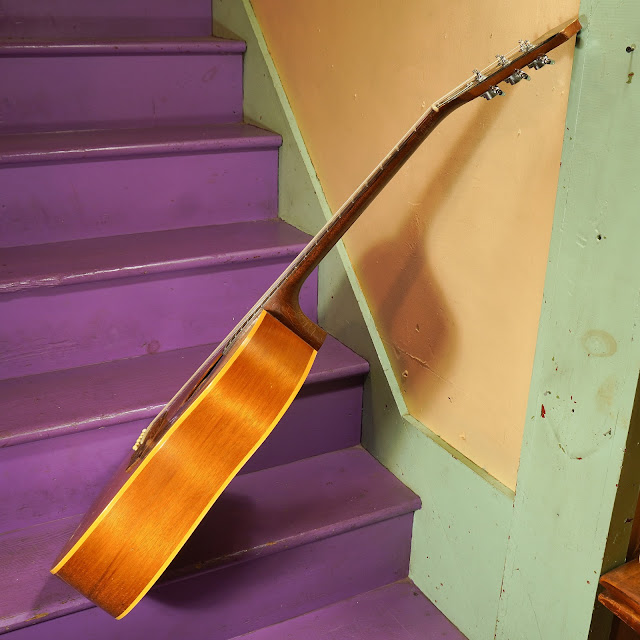1964 Epiphone (Gibson) FT-79N Texan Slope Dreadnought Guitar
I've worked on a bunch of old Epiphone Texans. This one happens to be a local customer's guitar and it was in for a "setup and crack repair" but wound-up getting a neck reset, fret level/dress, new saddle, and some fill for the crack that had opened-up a little above its old repairs on the back. Now that it's buttoned-up it's quite a fun instrument to play and it has a punchy, woody, thunky sort-of tone that sounds very '60s Gibson (fat, woody bottom!) but with a bit more snap from the long scale length.
I also appreciate the neat "Epiphone" pickguard shape and the Epi-style board inlay, too. Otherwise it looks about the same and is built about the same as a Gibson J-50 from the same time. Yes -- this is an Epiphone from when these were built right alongside Gibsons in Kalamazoo.
1960-1964 are popular years for these guitars and their Gibson counterparts, too, because the necks are not yet the very-slim, quick, rock-n-roll necks they would verge towards starting in '65. I actually like those better if what I'm doing is just flatpicked backup chords all night long, but a guitar like this is a much better option if you play a variety of styles -- flatpicked lead, fingerpicking, strumming, all of "the stuff."
In the tonal landscape, this guitar sits at the "tubbiest-sounding" point for Gibson design. Coming out of the mids-thick, stiffer (and taller) bracing of the '50s which suited the country-western and blues-fingerpicker sound, the late '50s and early '60s guitars got a lot lighter in the bracing and as a result sound fatter and warmer but lose some top-end chime and upper-mids definition. They become much-better chord-strumming instruments and they have the sound most folksies are looking for from a Gibson. The longer scale length (which = more tension per a given note) ramps-up the sustain and some of the mids-punch on this Epiphone version, though, but it's still a bottom-end-heavy instrument.
These guitars also sound a lot better out front than they do from behind, where they often sound a little muffled and "thin" from the player's perspective.
Normal J-50 specs are extant aside from the scale length change and trim changes -- it's got a solid spruce top, solid mahogany back, possibly ply mahogany sides, mahogany neck, and rosewood board and bridge. The original adjustable bridge (possibly a bolted plastic one) was removed and replaced by someone else a while back. The replacement is not too authentic and a bit oversized but it works swell and looks good enough for me to take home and strum! The tuners are also older replacement Grovers.
















Comments